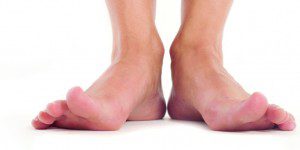By Myles Rubin Samotin, MD – Board Certified Orthopaedic Surgeon, Fellowship Trained in Foot and Ankle
 Look down at your feet right now! Do they seem different from ten years ago? Does your foot arch look the same as it did, or are you imagining that it has changed? Does your arch seem flatter to you? Well, maybe it has become flatter. And quite possibly that flatness may result in a lot of severe foot problems for you.
Look down at your feet right now! Do they seem different from ten years ago? Does your foot arch look the same as it did, or are you imagining that it has changed? Does your arch seem flatter to you? Well, maybe it has become flatter. And quite possibly that flatness may result in a lot of severe foot problems for you.
First, try the wet test. Wet your feet, then go and stand on a flat, dry surface that can leave an imprint of your foot. A normal footprint has a wide band connecting the ball of your foot to the heel, with an indentation on the middle, inner side of your imprint. A foot with a high arch has a large indentation and a very narrow connecting band, and conversely, a flatfoot leaves a nearly complete imprint with almost no curve.
There are several reasons for having flatfeet. They can be present at birth (congenital), caused by ongoing stresses to your foot, obesity, diabetes, Osteoarthritis, Rheumatoid arthritis, hypertension, or traumatic injury to your foot or ankle.
You may have flatfeet and be pain free. But you must understand that the arch in your foot is there to help distribute your weight across your entire foot. Painless flatfeet can deteriorate over the years and become painful. By that time, it may be too late to treat conservatively.
The signs and symptoms of flatfeet problems can include lower leg pain and weakness, pain around the inside ankle, sometimes with swelling.
You may have weakness inverting (pointing the toes inward) the foot. You may find that you have uneven shoe wear and notice that your regular shoes seem to be collapsing. You may also find that you have the inability to stand on your toes. Sometimes flatfeet can contribute or exacerbate other problems such as plantar fasciitis, posterior tibial tendonopathy, achilles tendonitis, shin splints, bunions, stress fractures and calluses.
So how should you treat this?
First, you should be properly evaluated by a Foot and Ankle Orthopaedic Specialist who will review your medical history and examine your feet, and if necessary, your gait.
Why an orthopaedist?
Simple!! The foot has twenty eight bones that need and should be evaluated by a bone doctor!!! Be sure to bring your regular shoes so that these may be examined. X-rays of both feet should be done for comparison and to determine, if it exists, the severity of the flatfoot. Muscle and tendon strength should be evaluated by your Orthopaedic Foot and Ankle Specialist.
Treatment can vary depending upon the cause. Conservative treatment can include shoe modifications, arch supports and custom orthotics. An injection of corticosteroid may be used to calm an inflammatory pain in your flatfoot. Resting and icing the involved extremity can help. Physical therapy may be necessary to strengthen and stretch the surrounding tissues, helping to alleviate the stress placed on to your affected foot.
However, frequently the only way to correct your painful foot is through surgery. Surgical procedures can help reduce or eliminate the pain and can improve bony alignment. They can include Arthrodesis, or welding (fusing) two bones together, Osteotomy or cutting or reshaping a bone to correct alignment, Excision or removal of extra bone or spurs, Synovectomy or cleaning the sheath of a tendon, and/or Tendon Transfer, to replace a worn or ruptured tendon.
Having flat feet can be a very serious matter. If you are experiencing foot pain and think it may be related to flatfeet, see an Orthopaedic Specialist as soon as possible. This is a problem that often worsens over time with treatment becoming more and more complicated. With 28 bones in your foot, you need to be evaluated by a Board Certified Orthopaedic Surgeon with a Sub-specialty, Fellowship Trained in Foot & Ankle surgery. In fact I am the only surgeon with these qualifications in our area. I believe this makes me uniquely able to deal with these problems in a state-of-the-art atmosphere and method that will keep you in good hands and provide you with the most desired result.
Myles Rubin Samotin, MD
Board Certified Orthopaedic Surgeon
Fellowship Trained, Sub-specialist in Foot and Ankle Surgery
Columbia University, Maimonides Medical Center,
Hospital for Joint Diseases, New York City
239.514.4200
870 111th Avenue North, Suite 4, Naples, Florida 34108
www.samotinorthopaedics.com








